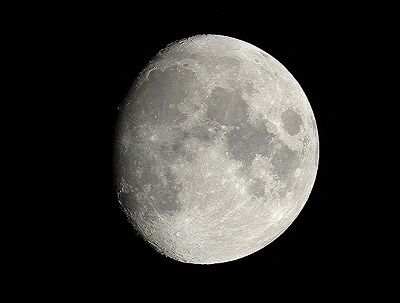If you were clouded out during the total eclipse of the moon last month, here is an image I made with our 6" refractor and a Nikon D70 digital camera*. Most of the time the moon was either invisible or barely visible through a layer of haze and clouds. Around 10:00 pm the sky cleared somewhat and I was able to make a number of images through the light haze that remained. Binoculars are useful in bringing out the color, though the haze made the color less visible. The 6" refractor has a focal ratio of f/12, so to be able to fit the image of the moon within the camera's field of view I used a combination telecompressor and field flattener to lower the f ratio to f/8.
For comparison, the view at right shows the appearance of the moon 3 days earlier on the evening of October 24th. Here the terminator, or line where the sun is rising on the moon, is on the left hand side of the image. Note how the long shadows cast by the rising sun bring out the surface detail along this line. In this image the sun is rising on Mare Imbrium (The Sea of Clouds) and Sinus Iridum (The Bay of Rainbows) near the top of the image and just includes Mare Humorum (The Sea of Moisture) about a third of the way from the bottom. Some prominent craters, from top to bottom, are Plato, with it's dark floor, Copernicus (center left) and, near the bottom, Tyco, with its bright ray system. Much of this detail can be seen in binoculars if you put them on a tripod or brace them against something steady. *If you have a telephone modem and the image is not sharp, your browser may be having trouble opening the image. Contact us if you have this problem.
|

